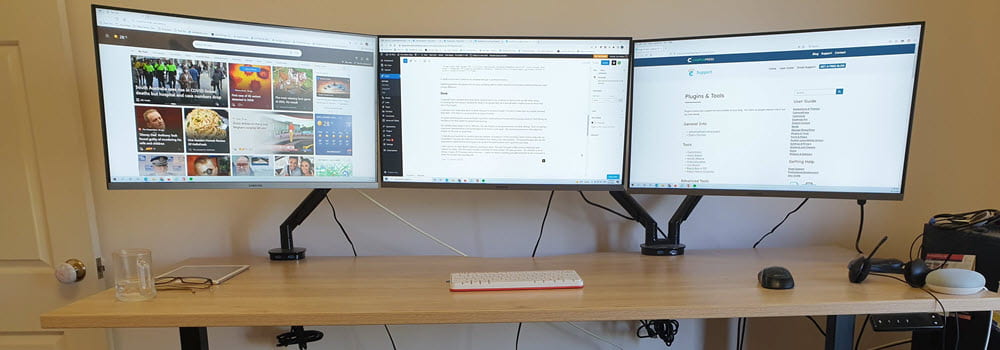Beth Kanter has got me thinking more about screencasting since I wrote my post on Quick Tips for Improving Screencasts because Beth loves Jing while I have mixed feelings. As Beth is way more experienced at screencasting, and my background is scientific research (yes I have kept that quiet), the only option was to investigate Jing deeper.
The Jing Project by TechSmith is currently allowing people free use of Jing and their web-hosting service screencast.com to capture images (and add notes to the images) or record it as a screen cast which you can then share free online at screencast.com.
Advantages:
1. Very easy to use
2. Easy to share images and screencasts
3. Superior quality
It does not change or diminish the resolution of your content which means the quality of the screencast is far superior (check out this screencast hosted on Google Video with this created with Jing). This means you could easily record the entire desktop and viewers would still be able to read the text in the screencast.
Disadvantages
1. Have to download two applications
To use you need to download both Jing and Microsoft .Net Framework 3.0. Some organisations are not keen on installing Microsoft .Net Framework 3.0.
2. Screencast is saved as .swf format.
The whole idea of Jing was they wanted to keep it very simple for very fast sharing of content. Unfortunately .swf is the hardest format to convert to another video format — which you need for: editing with MovieMaker, iMovie or Camtasia Studio); embedding in PowerPoint presentations; or playing on a mobile device. Trouble is people often do not realise the .swf format is an issue until then need to convert. Here is Jing Projects explanations for why they have limited file format — read the comments and you will see many have an issue with this format.
3. Will it remain free?
TechSmith explains that Jing is free to use, and to be hosted free at screencast.com for the duration of their testing. TechSmith traditionally sells software. They do state “As we learn what you want from this, we’ll have a better idea what the pricing and business model might look like in the future.”
TechSmith has been doing some interesting free product releases at the moment:
- Camtasia Studio 3.1.3 – Download a free copy of Camtasia Studio 3.1.3 here and request the free software key here (this will register your copy as a fully licensed version).
- SnagIT 7.2.5 – Download a free copy of SnagIT 7.2.5 here and request the free software key here (this will register your copy as a fully licensed version).
These are older versions of both software — which is not an issue for me with Camtasia Studio because I have not used it a lot but SnagIT 7.2.5 is nowhere near as good as the current version.
4. Causing my computer to start up slower
While making the application easier to use — they failed to make it obvious that you need to quit the application 🙂 (probably a Sue thing). Refer to diagram for how to shut down.
Comparison to Camtasia Studio 3.1.3 and CamStudio
1. Better video format options with Camtasia Studio and CamStudio
Camstudio records as .avi whereas Camtasia Studio can produce movie as AVI video , MOV (QuickTime Movie), WMV (Windows Media video) and Flash (SLV/FLV format). Means easily converted for mobile devices and easily edited to remove bits you don’t like.
2. Decreased quality of Camtasia Studio and CamStudio when hosted on video sharing websites like YouTube and Google Video
You will need to used fixed region, autopanning and certainly worth considering using use zoom/pan (as suggested by Beth) to optimise quality of screencast. None of this is required with Jing hence screencasts are tricker and slower to create using these two applications.
But hosting on sites like YouTube and Google video means you can embed easily in blogs which is not possible with Jing.
FINAL THOUGHT
Thanks Michele Martin for starting this conversation on screencasting even though the topic was originally on Evolution of a blog post (this is a good example of evolution 🙂 ) and thanks to Beth for sharing your expertise – check out Beth’s great screencasting wiki (especially her detailed sections: screencasts , resource list, examples of screencasts).
Very hard to recommend which is the best application to use for screencasts because it will come back to personal preference and what you are trying to achieve. My twitter network gave these various responses to their preference:
- Jing is incredibly easy, CamStudio can be a bear to get codecs right, Camtasia seems fairly intuitive…plus the webcam option! ( Since Camtasia (older version) is now free, it wins) – John Maklary
- Camtasia worked fine for us when we were making tv – mainly for web captures. For games/SL I prefer Fraps – skribe
- another option maybe wink – James Neill
- I like CamStudio for its simplicity – Wink also good for larger projects – Marg O’Connell
- I am for CamStudio too so easy to use and because it’s free – can’t comment on Jing haven’t used it. Wink would be 2nd choice – ozysteph1992
- fan of CamStudio (free and easy). Currently looking at Camtasia – more features than Studio (hence not as simple)- so far like it – Lance Treloar
- personally prefer CamStudio – got rid of Jing after to many conflicts – just got CamTasia and Snagit – Simon Brown
- I like Jings simplicity, but would go for Camtasia owing to its depth. My favourite is still Captivate though! – Andrew Brown
Would love to hear your thoughts on the pros and cons of the different free screencast software.
And if you’re enjoying this blog, please consider subscribing for free.




Leave a comment